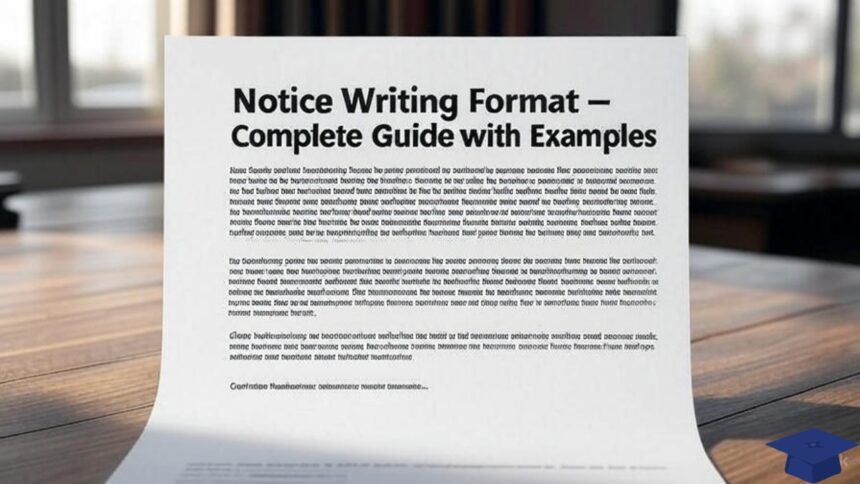Writing a notice is an essential skill for students, professionals, and even legal authorities. A notice is a short, formal piece of communication used to share information with a group of people. It can appear on school boards, office circulars, or in newspapers as a public or legal announcement. To make a notice effective, it must follow a proper format, use precise language, and remain concise.
This article explains the notice writing format in detail, covers style guidelines, and provides practical templates for both academic and legal purposes.
1. Core Structure & Essential Components
Regardless of the setting—school, college, office, or legal domain—a notice typically follows a structured layout. The essential components are:
1. Issuer’s Name or Organization
The first line should state the name of the issuing authority, such as a school, company, or government department. This immediately builds credibility and informs readers about the source.
2. Title (“NOTICE” or “PUBLIC NOTICE”)
The word “NOTICE” is written in uppercase, centered, and often bolded. For legal or property-related announcements, the phrase “PUBLIC NOTICE” is used.
3. Date
The date is written on the left side, just below the title. It provides an official record of when the notice was issued.
4. Subject or Heading
A concise and clear heading effectively highlights the purpose of the notice. For example, “Annual Sports Day” or “Notice of Property Transfer.”
5. Body / Content
This is the central part of the notice. The golden rule is to cover the 5 Ws:
- What is happening?
- When will it happen?
- Where will it take place?
- Who is involved or expected?
- Why is it important?
Sometimes, “How” is also included. The body should be written in simple, precise sentences without unnecessary details.
6. Contact Information
For public or legal notices, include a phone number, address, or email so that recipients can seek clarification or respond.
7. Signature, Name, and Designation
The issuing authority must sign every notice. The name and designation (such as Principal, HR Manager, or Advocate) add authenticity.
2. Style and Presentation Do’s & Don’ts
While writing a notice, presentation, and tone are just as important as the structure.
- Keep it brief: School notices typically range from 40 to 50 words. Public notices are concise but may include legal details.
- Use simple language: Avoid jargon or long, complex sentences. Passive voice is commonly used in formal notices.
- Clarity is key: State the purpose clearly and unambiguously.
- Proofread carefully: Errors in grammar or dates can confuse.
- Format neatly: Many notices are placed inside a box or table with bold headings and proper spacing.
3. Public & Legal Notices – Special Considerations
Notices published in newspapers or legal documents need additional care:
- Legal references: Mention case numbers, acts, or relevant laws if required.
- Deadlines: For example, a property notice may state that objections must be filed “within 15 days.”
- Publication rules: Follow the guidelines of the newspaper or gazette. Affidavits or supporting documents may also be necessary.
4. Sample Template – General Notice (School/Office)
[Name of Organization]
NOTICE
[Date]
[Subject / Heading]
[Body: Write in short sentences. Cover What, Who, When, Where, Why.]
[Contact Information if needed]
[Signature]
[Name]
[Designation]
Example:
National Model College
NOTICE
28 August 2025
Sports Day Participants Wanted
All students of classes 9–11 are invited to participate in the Annual Sports Day on 10 September 2025 at the school grounds. Please register in the sports office by 4 September 2025 between 9 a.m. and 2 p.m.
For queries, contact: Mr. Kumar, Sports Coordinator, Phone: 1234567890.
(Signature)
MR. RAO
PRINCIPAL
5. Sample Template – Public/Legal Notice
PUBLIC NOTICE
[Date]
Subject: Notice for Sale / Transfer of Property at [Address]
Please take notice that Mr./Ms. [Name], resident of [Address], (hereinafter “Owner”) has entered negotiations with Mr./Ms. [Name], resident of [Address], for the sale/transfer of the property located at [Property Details]. Any person claiming any interest, right, title, or lien in the said property, or having filed any legal proceedings regarding it, must submit such objections with documentary proof to the undersigned within fifteen (15) days from the date of publication. Failing this, the Owner will assume no adverse claims exist and proceed with the intended transaction.
Contact:
[Name], [Address]
Phone: [Number]
Email: [Email]
Signature:
[Name]
[Designation (e.g., Attorney)]
6. Quick Comparison: Academic vs. Public Notices
| Component | Academic/Office Notice | Public/Legal Notice |
|---|---|---|
| Issuer Name | Required | Required |
| Title | “NOTICE” | “PUBLIC NOTICE” |
| Date | Required | Required |
| Subject Heading | Concise | Formal and specific |
| Body Content | Short, covers 5 Ws | Detailed, with legal context |
| Contact Info | Optional | Mandatory |
| Signature & Designation | Required | Required |
| Legal References | Rare | Often included |
| Publication Format | School/Office boards | Newspaper or Gazette |
7. Pro Tips for Effective Notice Writing
- Use bold headings to highlight important parts.
- Avoid adding unnecessary details; stick to the facts.
- Choose passive voice when formality is required.
- Always check dates, venues, and deadlines.
- Follow official guidelines when publishing in newspapers.
- Proofread carefully—mistakes reduce credibility.
Final Thoughts
A well-written notice is precise, formal, and purposeful. Whether it’s a school announcement, an office circular, or a legal public notice, the format remains consistent:
Issuer – Title – Date – Subject – Body – Contact (if required) – Signature & Designation.
By following this format and keeping the language simple, you can draft notices that are professional, effective, and easy to understand.
Frequently Asked Questions
Q1. What is the ideal word limit for a notice?
Notices are intended to be concise and clear. In schools and offices, the ideal word limit is around 40–50 words. Public or legal notices may be longer if they include mandatory details, but they should remain concise.
Q2. Is the word “NOTICE” compulsory in a notice format?
Yes. The word “NOTICE” (or “PUBLIC NOTICE” for legal cases) should always be written in uppercase and placed at the top center. It draws attention and makes the document instantly recognizable.
Q3. Should a notice be written in active or passive voice?
Most notices are written in passive voice to maintain a formal tone. For example: “Students are requested to submit forms by 5th September.”
Q4. Who can issue a notice?
A notice must always be issued by an authorized person or organization, such as a principal, HR manager, government department, or property owner, through their authorized representative.
Q5. What are the 5 Ws in notice writing?
The body of a notice should answer the 5 Ws:
- What is happening?
- When is it happening?
- Where will it take place?
- Who is involved?
- Why is it important?
Q6. Can a notice include images or designs?
Academic and office notices are typically written in plain text, often enclosed in a box. Public notices in newspapers usually adhere to strict column formats and rarely include images, except for official logos or seals.
Q7. Why is contact information important in notices?
In school or office notices, contact details are optional. But in public and legal notices, they are necessary so that readers can raise objections, ask questions, or seek clarification.
Q8. What common mistakes should be avoided in notice writing?
- Using long, complex sentences.
- Missing essential details, such as date or venue.
- Writing in informal language.
- Forgetting the signature, name, or designation of the issuing authority.
Q9. Where are notices usually displayed or published?
- Academic/Office Notices: School boards, company noticeboards, official circulars.
- Public/Legal Notices: Newspapers, government gazettes, or online legal portals.
Q10. What makes a notice effective?
An adequate notice is clear, concise, formally written, and well-formatted, ensuring that readers can understand the information quickly without confusion.









